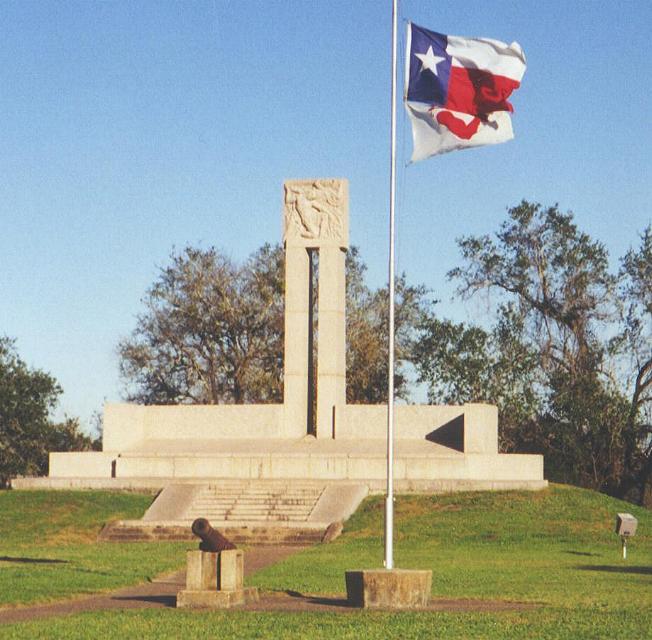SONS OF DEWITT COLONY TEXAS
Fannin's Fight & The Massacre at La Bahia (Goliad) The Men of Goliad by Unit and Fate Evacuation of Goliad,
Battle of Coleto & Surrender Fannin's Command at Goliad For Biographies, Search Handbook of Texas Online
Urrea's division, entering Texas by way of Matamoros, consisted of the cavalry regiment of Cuatla, the infantry battalion of Yucatan and some permanent militia-in all about one thousand men. Urrea's dragoons found Johnson, Grant, and Morris with about 97 men at and near San Patricio. The Texans had carelessly divided their forces, and both were surprised by Urrea and, with the latter's usual dispatch, all were butchered, except five or six, one of which was Johnson (left), who escaped. Placido Benavides, a prominent, wealthy Victoria Mexican in Grant's command, was among those who escaped. He hurried to Goliad and brought to Fannin the first news of the immediate approach of Urrea. A companion of Benevides, one Reuben R. Brown who came to Texas with the Georgia Volunteers, was wounded and captured, but was not executed. He afterwards attributed his escape from death to the intercession of a priest, and a Mexican lady, Senora Alavez, who was later to be known as the Angel of Goliad. These two Christian souls interceded for him as he was about to be shot, and through their pleas his life was spared.
But to Robinson, Fannin reported:
Fannin responded to Ayers request by sending Captain [Amon Butler] King, of the Georgia Battalion, with 28 men, to bring in the settlers. When King arrived at Refugio, about 28 or 30 miles from Goliad, he found himself confronted by Urrea's army. He, on the 12th, sent back for reinforcements, and the next day Fannin sent Lieutenant-Colonel [William] Ward, with 125 men to his relief. As by this time news of the fall of the Alamo had reached Fannin, he instructed Col. Ward to return as soon as possible. The night of the 13th, Fannin received orders from General Houston to blow up the fort and fall back on Victoria, where, on account of the barrier that the Guadalupe River forms, a more easily defended position might be maintained. This order was ignored. Some claim the reason was because Lt.-Gov. Robinson had ordered him on Feb. 21st to make no retrograde movement, but to await orders and reinforcements. Others claim he was awaiting the return of King and Ward from Refugio before retiring to Victona. It is more likely that his jealousy of Houston and determination not to serve under his command prompted his action in ignoring the order. [Historian John Henry] Brown says
On the 14th, scouts were sent out to hurry in the men at Refugio, but finding the Mexicans in Refugio, returned without information of King and Ward. On the same day, the La Bahia post was reinforced by the coming of Captain Albert C. Horton with a cavalry force of fifty-two men from Matagorda and the lower Colorado. On the 15th and 16th, scouts sent out to find King and Ward, returned without information. Then Captain Fraser, a citizen, at his own request went. He returned the same afternoon with the information of the defeat and annihilation of King's and Ward's forces, and the cold-blooded massacre of King's men. Most of Ward's men escaped toward Victoria, where they were subsequently captured and shared the fate of Fannin's men. Judge Harbert Davenport, whom General Hobart Huson calls the outstanding authority on the history of Fannin's Command, in his treatise The Men of Goliad, writes:
Before the fortifications were completed Travis' call came for Fannin to come to his aid at the Alamo. Fannin thought this move unadvisable and started strengthening his position in the Presidio. Here, under the directions of Chadwick and the Polish engineers, the men were put to strengthening the walls of the fort where it was needed, and a bastion was rebuilt at each of the southern angles. A covered way was built from the northwest comer of the fort down to the river, about two hundred yards distant, for the purpose of having a secure access to the water in case of emergency.---Fannin's men soon clashed with the Mexican citizens of La Bahia whom they called the Badenos. Some of the Americans when drunk and on night prowls outside the walls broke into the homes of the town people, molested their women and robbed and plundered. The citizens naturally became terrorized and, led by their devoted priest, Father Jose Valdez and Don Carlos de la Garza moved down to Carlos' Ranch, some 9 or 10 miles down the river. This ranch was, at that time, quite a thriving settlement, with a chapel, store and blacksmith shop, and, besides the Mexicans, some members of the Power-Hewetson Colony lived there, notably the Teals, Sidicks, Reileys and others. Joseph T. Williams, of the Georgia Battalion, describes Goliad as he saw it in the winter of 1836:
Davenport says
Don Carlos, unlike the De Leon family of Victoria, who threw in their lot with the Anglo-Americans, never wavered in his loyalty to Mexico, though he was born and reared in La Bahia. He raised a local company of natives, called Captain de la Garza's Victorian Guards,--and it was this company that intercepted the retreat of King's men from Refugio on their way to Goliad. He captured most of the band at the Melone Ranch (now a part of the O'Connor Mellon Creek Ranch), on the Mellon (Melone) Creek. Captain de la Garza's company scoured the territory between the Mission and San Antonio River and found different parties of Ward's Command who were lost on these prairies trying to find their way to Victoria. These he delivered up to the Mexican Commander at Refugio. By the end of February, Fannin had been notified of the approach of Urrea's Army. Johnson and four or five others, fleeing from San Patricio, where they barely escaped with their lives, warned him that Urrea with a division of three thousand troops was nearing. Still Fannin dallied, even after he learned of the fall of the Alamo, and the news that Captain Hugh Fraser brought of the capture and butchery of King's and Ward's men, and in spite of the orders he had received from General Houston,--now recognized by all except Fannin as Commander-in-Chief of the Texas Army, to destroy the fort of La Bahia and to retreat to Victoria, a position on the Guadalupe River more capable of defense. Houston's order to evacuate the fort came to Fannin on March 12. From that date to the 17th no move was made to obey the order. But late that day the scout, John White Bower, came in with the warning that a large force of the enemy was in the vicinity. Only then were preparations began for leaving. On March 17, Colonel Horton, who had been reconnoitering the country between Goliad and San Antonio, reported to Fannin that Col. Morales' force to the number of some 1500 were approaching and would unite with Urrea's army south of the Mission of Refugio. Another Council of War was held, and the unanimous opinion was that an immediate retreat should be made the next day. Other scouts coming in now, reporting large enemy forces were seen near by, so alarmed Fannin that he gave orders that the cannon that they had buried should be dug up and remounted and preparations made to repel an attack. He ordered his troops to destroy the whole town of La Bahia by fire, battering down all ruined walls, so as to secure a full sweep of the enemy should they attack the fort. On the morning of the 18th a party of the enemy was discovered to be scouting around very near the fort. Col. Horton, with a few horsemen, was sent out to chase them off. At first he succeeded in driving his opponents off, but when he had chased them a short distance he ran into a larger force of the Mexicans who in turn chased him (Horton's men) back into the fort. These clashes kept up, back and forth, most of the day and were witnessed with high glee and excitement by the men at the fort-perched upon the roofs and parapets. However, this delayed all preparations for the retreat which Fannin was at last convinced must begin. All of the horses which had been used by Horton's men were worn down and jaded. In the excitement of watching the fighting outside the fort the oxen which had been, with so much trouble and sacrifice, supplied by Linn and Kerr from Victoria were left hitched to the cannon without food and water all day long so were in no condition to haul the cannon and supplies. So the retreat had to be put off until the next day. Fannin, with characteristic indecision, now ordered the cannon buried before he abandoned Goliad. Then he instructed the men to dig up the guns and open a trench around the fort. As instructed by Houston, he had destroyed everything in and about the fort that he could not take with him. Everything that would burn was fired---what grain and food he could not carry in the carts was piled up in the Chapel of the fort and set on fire. Marks of this fire are still to be seen in the front end of Our Lady of Loreto Chapel. Walls of the fortification were torn down and all houses outside the walls were burned or otherwise destroyed. Nine cannon and several cart-loads of ammunition, baggage, and supplies were taken along as they left the fort, but by some oversight food was forgotten. The morning of March 19, opened with a heavy fog, which helped mask the retreat. It was 9 or 10 o'clock before breakfast for all the men could be finished. Then much time was lost loading the carts with the cannons, artillery, soldiers' baggage, and hitching up the oxen, and spiking those guns that they left. But alas!---they forgot to load food. Finally they were off, taking the road to Victoria. Immediately they had to cross the river, but at the old ford the banks were to high that much difficulty was experienced in getting the heavily loaded carts across, some of the carts having to be unloaded, then reloaded, so more time was lost. Setting out on the march across the prairies it was found that the teams were weak and easily tired and so frequent rests were necessary. With the exception of Horton's Company all the men were afoot. After crossing the Manahuilla Creek, a few miles farther on, a halt was made to allow the animals to graze where the grass was greened up after the prairie had been burned off. The scouts reported the enemy army was only four or five miles off, but did not seem to be pursuing the Texans. Captain Horton's Company of about 30 horsemen was directed to scout around and give notice of any appearance of the enemy, so the Commanders felt secure. Going on about two miles the teams showing signs of breaking down, it was thought advisable to call another halt. Here on a low ridge with no natural protection, but in sight of the Coleto Creek timber line, the halt was made. But just then it was discovered that the enemy were emerging from the timber. Quickly the six-pounder cannon was unlimbered and three shots fired at them, but it was seen that the shots fell short of the target. It seems that Horton had left four of his men in the rear of the Texans' line of retreat to keep a lookout for the Mexican Army and to warn Fannin. Instead the four dismounted to rest, and fell asleep. The enemy was upon them before they knew it. Hastily mounting their horses they wildly fled in the greatest terror, and passing about a hundred yards on the right of the Texas army, without even stopping to look at their comrades on foot, thirty fled on accompanied by the curses of the men they were supposed to warn. Col. Fannin, on seeing the Mexican Army coming from the woods, still ordered his men to resume the march. Before anything could be done with the ammunition the Mexican Army closed around the Texans and opened fire upon them. Now the fight began in earnest. Soon it was seen that the enemy were being reinforced by other troops, until there must have been over one thousand fighting against Fannin's three hundred. sdct
Thus were events leading to the Battle of Coleto Creek ending with the capture and subsequent massacre of Fannin's command. The Texan troops at Victoria on learning of the defeat of Fannin's troops quickly withdrew to join the scattered Texas bands at Gonzales and on the Colorado and Brazos Rivers, where they were eventually joined by most of the escapees. They were closely followed by the Mexican Army, but not before some of them joined Houston at San Jacinto. In that battle the rallying call of the Texans was: "Remember Goliad, "Remember the Alamo." After the glorious victory at San Jacinto and the capture of the butcher of Fannin's men, Santa Anna, by the Texans, Filisola was put in command of the defeated Mexican Army and began the famous "Filisola's Retreat" to Mexico, in accordance with the treaty between Houston and Santa Anna. He came by Goliad, but did not dare enter it, as he feared the tempers of the few---very few---remaining men there. He was escorted on the retreat by the Texan army under Gen. Thomas J. Rusk, who established his headquarters at Victoria, while he pushed on to Goliad to see that Filisola did not stop there. This was about June 3rd. Here the ghastly remains of the massacred men of Fannin's Command were found in the partially covered trenches where they had been dumped and burned. Some bones, gnawed by coyotes and dogs were on top of the ground. General Rusk immediately gave orders for a formal military burial of the bones. Rusk issued the following order for the military funeral:
On reaching the grave General Rusk delivered a short, but feeling and eloquent address.
A map of the town tract of Goliad was made in 1857, from data furnished by Dr. Barnard, and is on file in the County clerk's office of Goliad County. It indicates certain spots where Fannin's men were buried by Rusk's Texans. Dr. Barnard is believed to have had first hand information as to the actual site of the burial. For many years this place remained unmarked and unprotected, until the very location was almost forgotten-almost, but not quite. One old citizen of Goliad, Mr. George Von Dohlen, who was a prominent merchant there in 1858, remembered the spot had been pointed out to him by some people who lived in La Bahia in 1836, as the location of the trench. He gathered up rocks and piled them on the place pointed out, to keep the cattle and animals from tramping on it, he said. This pile of rocks interested a group of Boy Scouts and their leader in 1930 when they found a few bone fragments that had been dug up there by rodents or armadillos, and reported their find to their families.
Thomas Rusk to Mirabeau Lamar. Nacogdoches, 23d April, 1837. To GENERAL M. B. LAMAR. Dear Sir,-As you intend writing some account of the War with Mexico, I know that you will do the brave Col. Fannin and his men that justice which, so far, has not been done. Santa Anna and General Urea have both published to the world base and palpable slanders upon their memory, which, so far as I have seen, have not yet been repelled properly. It is not my purpose now to advert to any of the proofs which exist that Urea formed a Treaty with Col. Fannin, by which he was to receive for himself and all his men the usual treatment of prisoners of war. I only intend to refer to the statements made by General Santa Anna, immediately after he was brought into our camp a prisoner. During the first conversation which he held after being brought in, he alluded to Colonel Fannin and his men. No one had asked him about the matter, up to the time he commenced the conversation himself. What was first said, I do not distinctly recollect; but as soon as he commenced talking on that subject, I gave strict attention to what he said. He did not pretend to deny the existence of the Treaty; but denied that he had given a positive order to have them shot. He said that the Law of Mexico required, that all who were taken with arms in their hands should be shot; that General Urea was an officer of the Government, and could enter into no contract in violation of the Laws; and was going on with a course of reasoning, to show the correctness of his position, when I interrupted him, and told him Urea had made a Treaty stipulating to extend to Fannin and his men the usual treatment of prisoners of war; that that agreement alone had induced them to surrender, and that to shoot them in violation of that treaty afterwards, whatever might be the laws of Mexico, was murder of the blackest character; and that if he regarded the preservation of his own life, it would perhaps be well for him to offer no palliation to a crime which would blacken the character of all the officers concerned in it, and would attach disgrace to the Mexican Nation as long as its history should continue to be recorded. I hope, Sir, that you have been able to collect all the facts relative to that affair; and that, in your proposed history, ample justice will be done to the memory of those brave martyrs to our cause, many of whom came from the same state with ourselves. With great respect, yours, THOMAS J. RUSK. sdct Independence-Index |
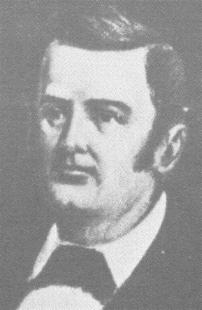 [James
Walker] Fannin took command at Goliad in the latter part of January, 1836. Houston had
retired to east Texas and was, until early in March, engaged in treaty making with the
Indians there, and in tending to his personal affairs. Early in January the Texans had
information that Santa Anna was leading a large force to invade Texas and to subdue her in
retaliation for the severe defeat the Mexicans had received at the hands of the Texans at
San Antonio and Lipantitlan. Houston was in favor of withdrawing to east Texas and there
to consolidate and hold the army. Fannin, Grant, and Johnson wanted to meet the enemy on
the border and keep the war out of Texas. The divided state of command and authority among
the Texans resulted in nothing being done until the Mexican Army was upon them. On
February 23, Santa Anna appeared before San Antonio, where only a feeble garrison, under
Travis, awaited him. Travis withdrew into the Alamo and was besieged by Santa Anna's
vastly superior force.
[James
Walker] Fannin took command at Goliad in the latter part of January, 1836. Houston had
retired to east Texas and was, until early in March, engaged in treaty making with the
Indians there, and in tending to his personal affairs. Early in January the Texans had
information that Santa Anna was leading a large force to invade Texas and to subdue her in
retaliation for the severe defeat the Mexicans had received at the hands of the Texans at
San Antonio and Lipantitlan. Houston was in favor of withdrawing to east Texas and there
to consolidate and hold the army. Fannin, Grant, and Johnson wanted to meet the enemy on
the border and keep the war out of Texas. The divided state of command and authority among
the Texans resulted in nothing being done until the Mexican Army was upon them. On
February 23, Santa Anna appeared before San Antonio, where only a feeble garrison, under
Travis, awaited him. Travis withdrew into the Alamo and was besieged by Santa Anna's
vastly superior force. 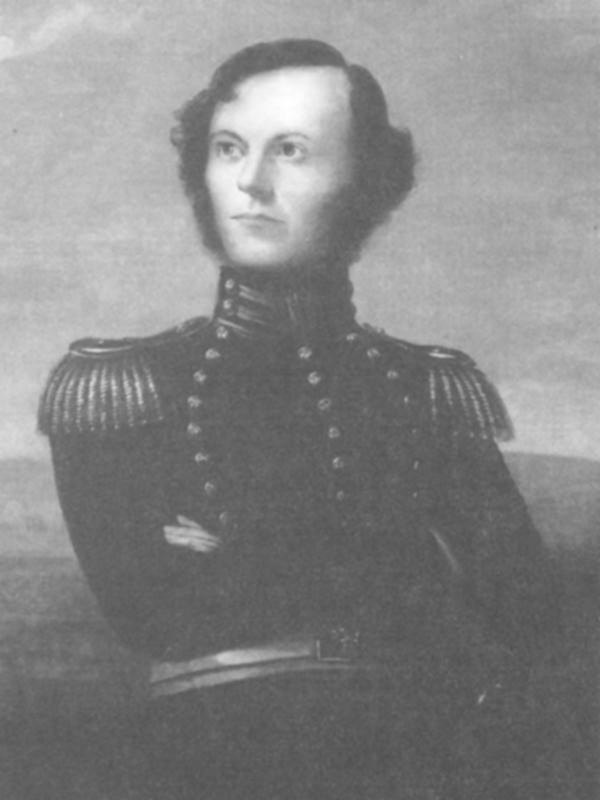 [Fannin Likenesses:
Similar to those of
[Fannin Likenesses:
Similar to those of 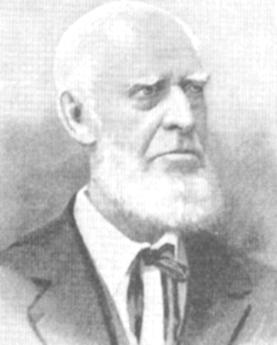 Houston had now been recalled to
the command of the army by the government. He repaired to Gonzales, where the Texans had
gathered in numbers to meet the invaders. There, he assumed command of these and all other
Texas troops. Travis, besieged in the Alamo, had been making frantic efforts to get
reinforcements. He sent Bonham to Goliad and Gonzales to beg for help. From the latter
place a company, on March third, stole through the enemy lines and joined the band in the
Alamo. Fannin, on February 25, left Fort Defiance, as he had re-christened old La Bahia,
to go to the aid of Travis. As he had broken off all relations with Governor Smith, Fannin
made his reports to
Houston had now been recalled to
the command of the army by the government. He repaired to Gonzales, where the Texans had
gathered in numbers to meet the invaders. There, he assumed command of these and all other
Texas troops. Travis, besieged in the Alamo, had been making frantic efforts to get
reinforcements. He sent Bonham to Goliad and Gonzales to beg for help. From the latter
place a company, on March third, stole through the enemy lines and joined the band in the
Alamo. Fannin, on February 25, left Fort Defiance, as he had re-christened old La Bahia,
to go to the aid of Travis. As he had broken off all relations with Governor Smith, Fannin
made his reports to 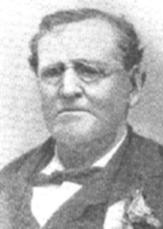 This, from Fannin's own hand, makes it hard for us to
understand why, in view of his information of the coming of the Mexican Army, he did not
keep his small force together after he decided not to go to the relief of the Alamo. But
he did not. The Irish Colonists settlers, realizing the danger to their lives and
properties from the approaching Mexican Army, had fled eastward, joining others in what is
now known as The Runaway Scrape, though some of them got no further than Victoria. About
March 10th, the notorious
This, from Fannin's own hand, makes it hard for us to
understand why, in view of his information of the coming of the Mexican Army, he did not
keep his small force together after he decided not to go to the relief of the Alamo. But
he did not. The Irish Colonists settlers, realizing the danger to their lives and
properties from the approaching Mexican Army, had fled eastward, joining others in what is
now known as The Runaway Scrape, though some of them got no further than Victoria. About
March 10th, the notorious 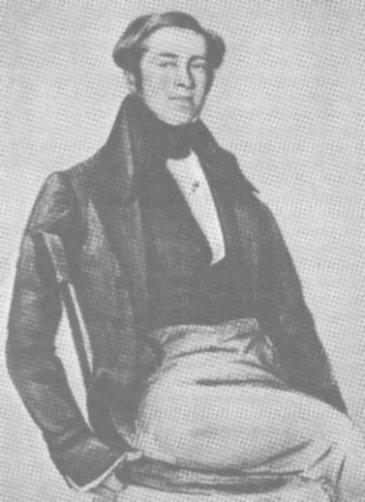 [Photo: Photo of a
portrait from The Presidio La Bahia by Kathryn O'Connor] This strengthening of the
fortifications of the old fort was done according to the plans and under the direction of
Captain [Joseph M.] Chadwick, whose map we still have and which has been a guide to the
restoring of the Presidio in 1963-65. He was assisted by Captain
[Photo: Photo of a
portrait from The Presidio La Bahia by Kathryn O'Connor] This strengthening of the
fortifications of the old fort was done according to the plans and under the direction of
Captain [Joseph M.] Chadwick, whose map we still have and which has been a guide to the
restoring of the Presidio in 1963-65. He was assisted by Captain 